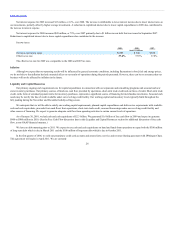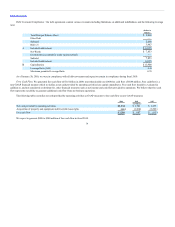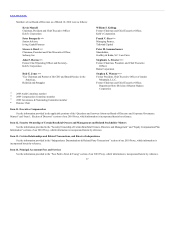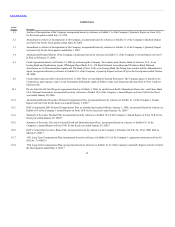Kohl's 2009 Annual Report Download - page 33
Download and view the complete annual report
Please find page 33 of the 2009 Kohl's annual report below. You can navigate through the pages in the report by either clicking on the pages listed below, or by using the keyword search tool below to find specific information within the annual report.
Table of Contents
Operating Leases
As of January 30, 2010, we leased 686 of our 1,058 retail stores. Many lease agreements contain rent holidays, rent escalation clauses and/or contingent
rent provisions. We recognize rent expense on a straight-line basis over the expected lease term, including cancelable option periods where failure to exercise
such options would result in an economic penalty. We use a time period for our straight-line rent expense calculation that equals or exceeds the time period used
for depreciation. In addition, the commencement date of the lease term is the earlier of the date when we become legally obligated for the rent payments or the
date when we take possession of the building or land for initial setup of fixtures and merchandise or land improvements.
All of our long-term debt at year-end 2009 is at fixed interest rates and, therefore, is not affected by changes in interest rates. When our long-term debt
instruments mature, we may refinance them at then existing market interest rates, which may be more or less than interest rates on the maturing debt.
Cash equivalents and long-term investments earn interest at variable rates and are affected by changes in interest rates. During 2009, average
investments were $1.6 billion and average yield was 0.6%. If interest rates on the average 2009 variable rate cash equivalents and long-term investments
increased by 100 basis points, our annual interest income would also increase by approximately $16 million assuming comparable investment levels.
We were not a party to any material derivative financial instruments in 2009, 2008 or 2007.
The financial statements are included in this report beginning on page F-3.
None
(a) Evaluation of Disclosure Controls and Procedures
Under the supervision and with the participation of our management, including our Chief Executive Officer and Chief Financial Officer, we carried out
an evaluation of the effectiveness of the design and operation of our disclosure controls and procedures (the “Evaluation”) at a reasonable assurance level as of
the last day of the period covered by this Report.
Based upon the Evaluation, our Chief Executive Officer and Chief Financial Officer concluded that our disclosure controls and procedures are effective
at the reasonable assurance level. Disclosure controls and procedures are defined by Rules 13a-15(e) and 15d-15(e) of the Securities Exchange Act of 1934 (the
“Exchange Act”) as controls and other procedures that are designed to ensure that information required to be disclosed in the reports that we file or submit
under the Exchange Act is recorded, processed, summarized and reported within the time periods specified by the SEC’s rules and forms. Disclosure controls
and procedures include, without limitation, controls and procedures designed to ensure that information required to be disclosed in the reports that we file or
submit under the Exchange Act is accumulated and communicated to our management, including our Chief Executive Officer and Chief Financial Officer, to
allow timely decisions regarding required disclosures.
It should be noted that the design of any system of controls is based in part upon certain assumptions about the likelihood of future events, and there
can be no assurance that any design will succeed in achieving our stated goals under all potential future conditions, regardless of how remote.
33
























